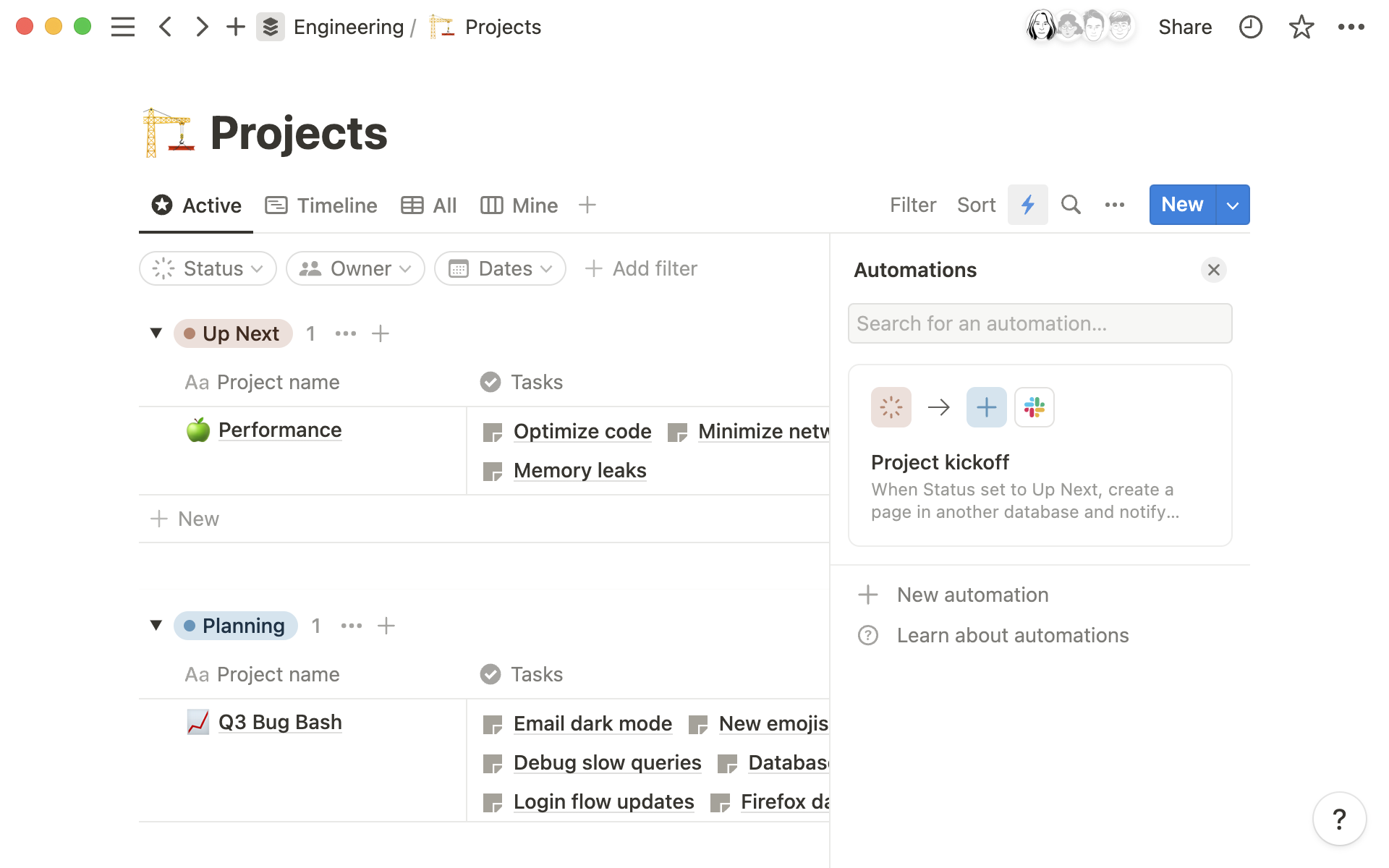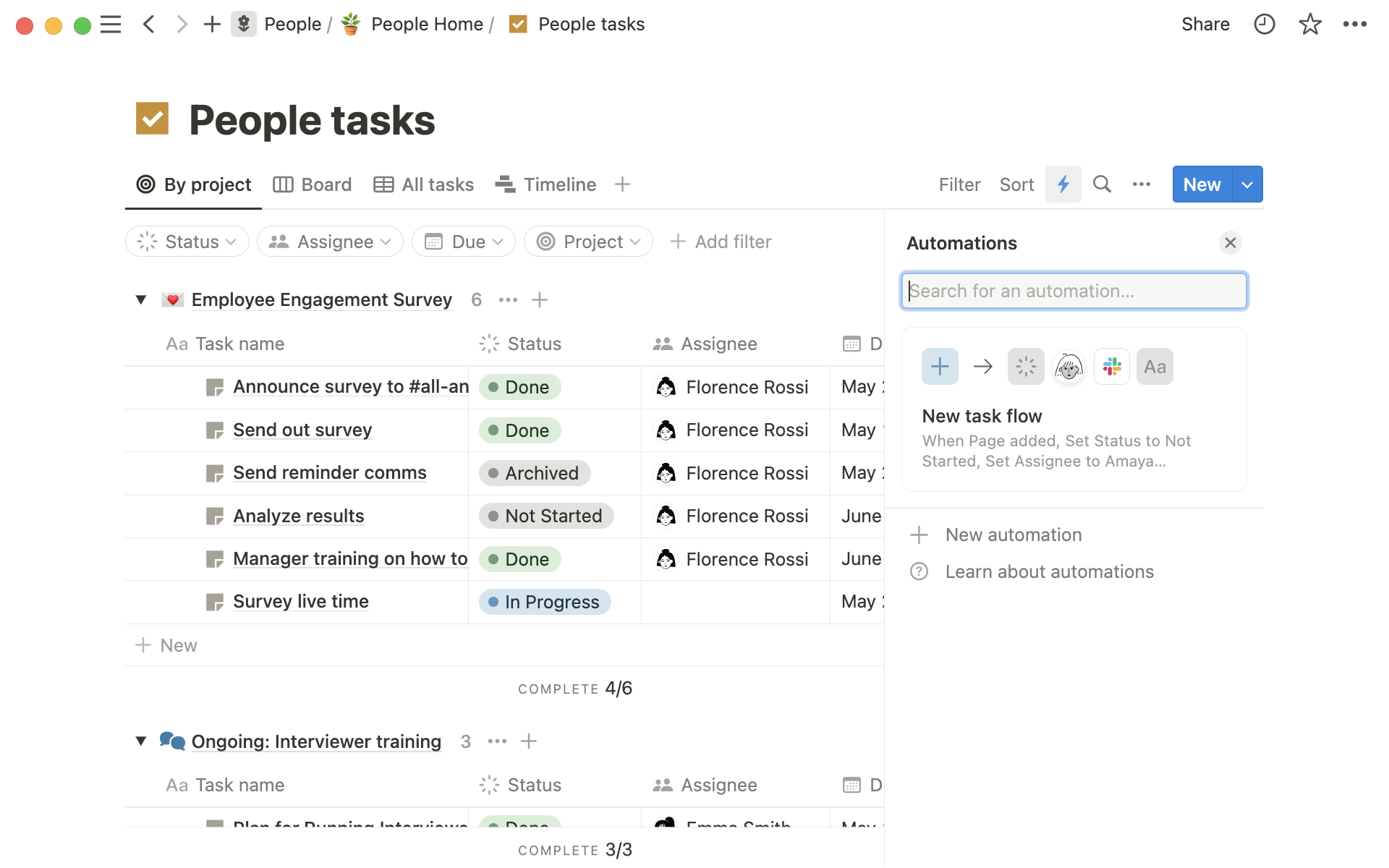Create streamlined project management workflows using database automations
Database automations give you the power to create custom workflows handling the repetitive admin tasks of project management, so you’ll spend less time clicking buttons and more time on high-impact work.

- How database automations save time and let you focus on the bigger picture
- Set up workflows for your tasks and projects
- Three automations for Notion Projects
- 1. Start a new task
- 2. Kick off a project
- 3. Complete a project
- More database automations for all your work
As a project manager (or anyone who manages work), you might be inundated with repetitive tasks — updating project statuses, adding and assigning new tasks, sending out reminders, and so on, all the way from project kickoff to sign-off.
The manual workload increases as your team grows, but with Notion these tedious tasks can become database automations you set and forget.
In this guide, we’ll show you how to use database automations to set up custom workflows to streamline your processes and make sure nothing slips through the cracks.

How database automations save time and let you focus on the bigger picture
Database automations consist of trigger events and the sequence of actions that follows. You’ll set up triggers and subsequent actions which are based on changes within database properties. The automation is structured as follows: “When any of these occur (a trigger), do this (an action).
So, for example, your trigger could be when a new page is added to the database, and the resulting actions might fill up some properties with your chosen responses.
Database automations can complete or update properties, add or edit pages in another database, send Slack notifications, and more. You can customize automations as needed and have several running in the same database for different scenarios.
While this feature is available in any Notion database, it’s uniquely powerful in the context of project management, where you need accurate workflows where nothing gets lost, missed, or forgotten.
By creating database automations, you can:
Reduce wasted time between tasks — Instead of your team members waiting around to be assigned their next project, they’ll be notified whenever something new lands on their plate.
Prevent human error — When your team is juggling multiple projects, it’s often the manual tasks (like re-assigning a task) that get forgotten. Setting up automations will reduce everyone’s cognitive load and prevent anything from getting missed.
Consolidate project management — Because database automations are native to Notion, you don’t need to create complex workflows using third-party tools. You can do all your project management in Notion to keep your team focused and reduce context-switching.
Database automations are only available on some plan types
Set up workflows for your tasks and projects
You can set up database automations in a few simple steps.
In your projects or tasks database:
Go to the options menu … and select
Automationsor just click on the lightning bolt icon.Choose
New automationand rename it if you wish.Next, select your triggers, which can be when a new page is added, a certain property (or properties) are edited, or
Any propertyis edited. Triggers are formatted as “or” statements, so if any one of the triggers occurs, the automation will occur.Choose the resulting actions, such as adding a new page to this database or another database, editing a property (in this database or another), send a Slack notification.
Click
Createto save the automation.
Anytime you want to edit your automations, come back to the menu and make your changes.
Choose which pages your automation will apply to
Three automations for Notion Projects
Ready to start building your own automations?
Here are some helpful examples to try out in your projects and tasks databases.
1. Start a new task
Every time you add a new task to your database, you can assign that task to someone, send them a notification, and give it the correct status.
To do this, create a new task and call it something like “New task flow”. Go to + Add trigger and select + Page added.
In the + Add action menu, give all new pages the status Not Started, and select a team member to assign them to. Finally, click Send Slack notification to and choose who you want to notify.
Now, whenever you add a new task, you’ll see all those properties are completed, and a Slack notification is sent.
Editing Slack notifications
2. Kick off a project
To simplify the process of kicking off a project, you can create a Project kickoff automation in your Projects database.
The trigger will be when a project’s status is changed from Not started to Up next, and the actions that follow will automatically schedule a project kickoff meeting and notify the project manager.
In the Actions menu, select Add page to and find the meeting notes database. Call the new page Project Kickoff and click Edit another property to tag all team members and set the meeting date to Today, which will be the current date whenever the workflow is triggered. Finally, we can send a Slack notification to the project manager to alert them that the project is about to kick off.
3. Complete a project
Project managers can sign off a project with one click using this automation.
First, add a checkbox property to your projects database and call it something like Sign off. Next, create an automation where the trigger is an update to the sign-off property.
When you select the checkbox, you can then change the Status of all related tasks to complete, notify your team’s Slack channel and update the Completed date to Today.
More database automations for all your work
There are infinite ways to build efficient workflows across your entire workspace with database automations.
Want some more inspiration?
Here are more suggestions for ways to use database automations in your personal and professional life - with helpful templates to get started.
Add closing dates to your sales pipeline — When you mark a deal as
Closedin your Sales Pipeline, automatically set theDate closedproperty to today, and send a notification to your#saleswinsSlack channel.Assign an interviewer for new candidates — In your company’s Applicant Tracker, an automation will tag the engineering team lead as
Interviewerwhenever you add a new candidate for the engineering team. You can create similar automations for other teams.Mark courses you’re currently enrolled in — When you add a new course to the Courses database in your Assignment Tracker, the
Currenty enrolledproperty will automatically be checked off.Remind yourself to budget for taxes — Whenever you introduce a new item tagged as
Freelance,Side hustle(or another category of your choice) into your Personal Finance database, you’ll get a Slack notification reminding you to set aside money for tax.Mark started and finished dates on your reading list — Complete
StartedandCompleteddates for all books you read and organize in your Reading List.
Templates with built-in automations
Some of our templates have built-in automations — these are free for anyone to use. If you’re on a paid plan, you’ll be able to edit these automations according to your workflow.
Something we didn't cover?